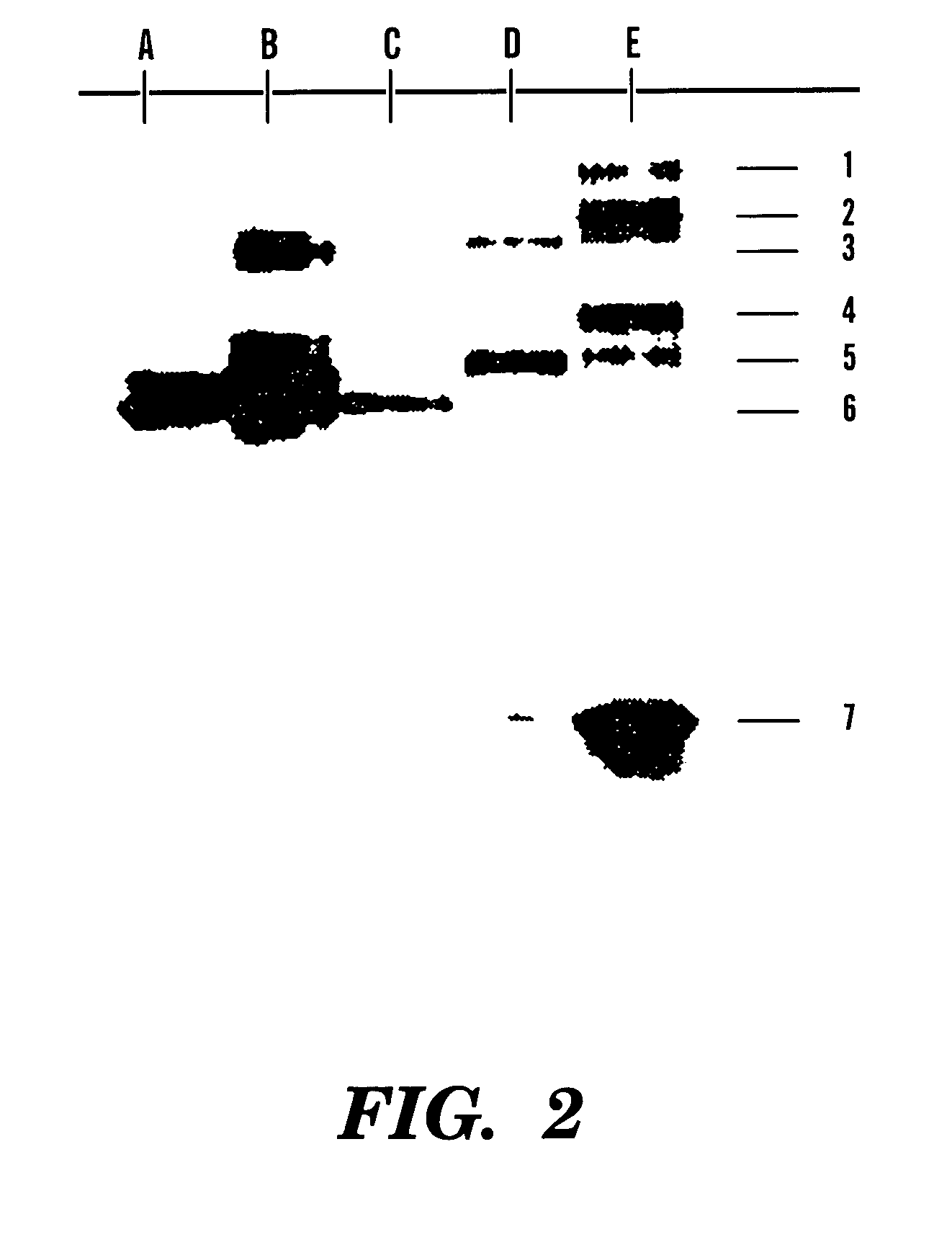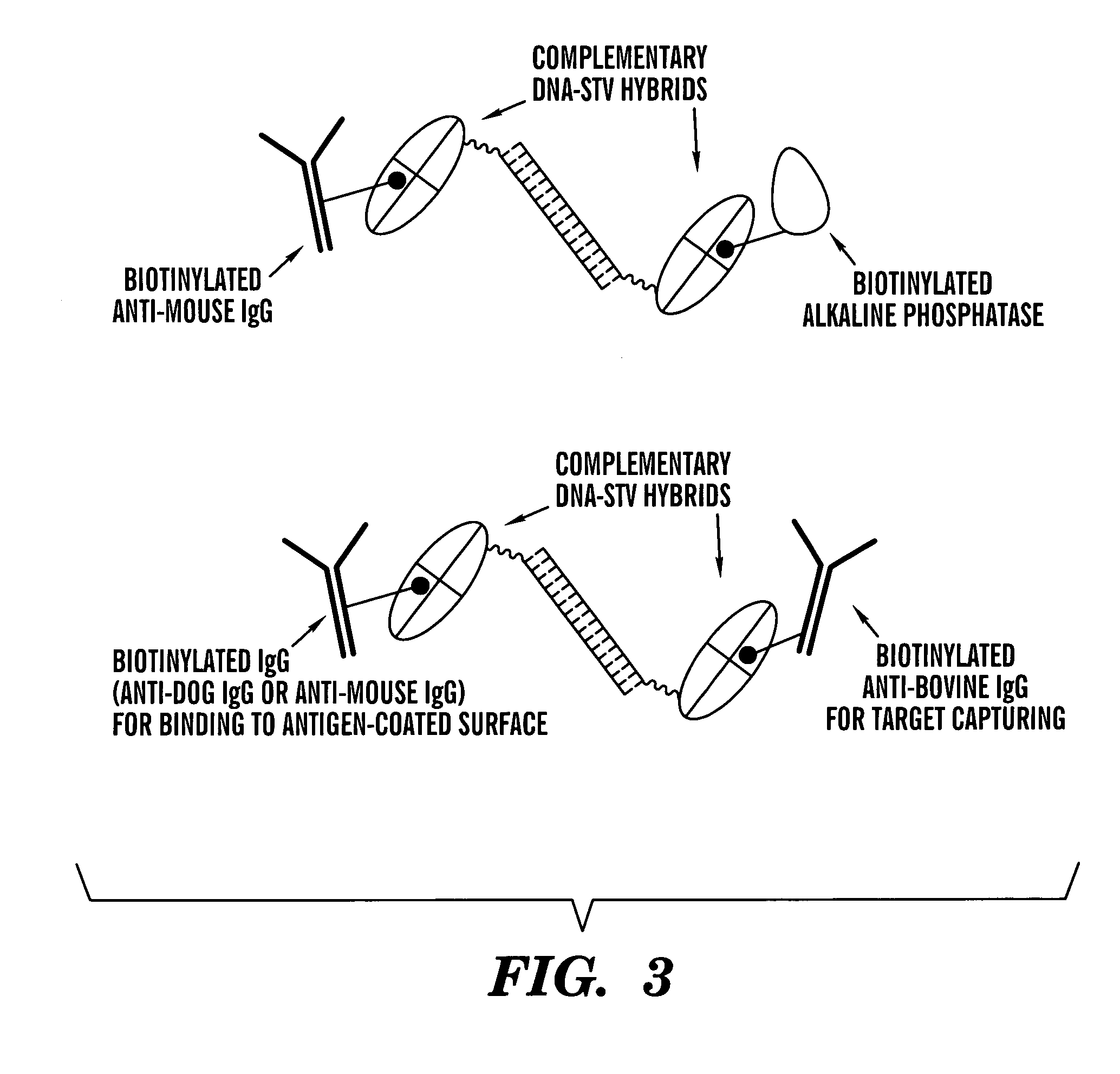Nucleic acid directed immobilization arrays and methods of assembly
a technology of nucleic acid and array, which is applied in the field can solve the problems of long duration of current synthesis procedure, lack of uniform conjugation technique, and inability to cross-link the enormous variety of functional macromolecules available, so as to reduce the cost of supramolecular compound construction, increase regiospecificity and resolution, and reduce the effect of cos
- Summary
- Abstract
- Description
- Claims
- Application Information
AI Technical Summary
Benefits of technology
Problems solved by technology
Method used
Image
Examples
example 1
Synthesis of Nucleic Acids
[0085]The electrophilic addition of thiols to maleimides yielding stable thioester conjugates was chosen as the crosslinking reaction for the conjugation of streptavidin to nucleic acids. Oligonucleotides were purchased (Operon Technologies; Alameda, Calif.) and used without further purification. Thiolated oligonucleotides were purchased and delivered with a disulfide protection group (5′-PGS), which was removed by incubating 6 mM of oligonucleotide with 15 mM DTT dissolved in PBE (phosphate-buffered EDTA; 100 mM phosphate buffer, pH 6.8, 5 mM EDTA) at 37° C. for one hour. After deprotection the disulfide protection group was removed by gel filtration chromatography with a Sephadex G-25 column, NAP-10 columns (Pharmacia Biotech; Piscataway, N.J.).
[0086]The oligonucleotides synthesized are listed in Table 3.
[0087]
TABLE 3Oligonucleotide SequencesNameSequenceUA5′-PGS-TCC TGT GTG AAA TTG TTA TCC GCT-3′(SEQ ID NO 1)TC-UA5′-PGS-AGC GGA TAA CAA TTT CAC ACA GGA-3′(...
example 2
Synthesis of Heterobifunctional Conjugate
[0092]Streptavidin (Boehringer Mannheim; Indianapolis, Ind.) was derivatized with excess sulfosuccinimidyl 4-[p-maleimidophenyl] butyrate (sulfo-SMPB; Pierce; Rockford, Ill.), a heterobispecific crosslinker, in a 600 ml reaction mixture, consisting of 3.8 mg / ml protein and 0.25 mg / ml sulfo-SMPB in PBS (100 mM K phosphate buffer, 7.3, 150 mM NaCl) to provide a maleimide functionality. After incubation for one hour at room temperature, products were desalted by ultrafiltration (30,000 MW cut-off membrane) and the buffer changed to PBE. Derivatized streptavidin (200 ml, 3.5 mg / ml in PBE) was mixed with 200 ml of a deprotected thiolated oligonucleotide (0.7 mM in PBE) at room temperature to yield a stable thioether-linked DNA-streptavidin conjugate. After 15 minutes and 30 minutes another 200 ml aliquot of the DNA solution was added. The mixture was incubated for an additional 30 minutes and excess DNA was removed by ultrafiltration (Centricon 30...
example 3
Synthesis ad Analysis of Biotinylated DNA-Streptavidin Conjugates
[0100]Control samples were prepared from streptavidin and the biotinylated oligonucleotide BRSP-48. Streptavidin (5 mg / ml; 900 pmol in 10 ml) was diluted with 20 ml of TE and 20 ml of a BRSP-48 solution (48 pmol / ml; 1.06 equivalents) were added. The mixture was incubated at room temperature on a shaker for 30 minutes. Similar mixtures were prepared containing the same final streptavidin concentration (1 mg / ml) with various biotinylated DNA concentrations, ranging from 4.7-144 pmol / ml (0.25-8 molar equivalents, respectively). Typically 5-8 ml of these solutions were mixed with 2 ml of a non-denaturing PAGE sample buffer and analyzed by gel electrophoresis.
[0101]Non-denaturing PAGE studies were performed on 8.5% polyacrylamide gels. Samples were applied as 5-15 ml portions containing 0.1-1 mg / ml protein (e.g. streptavidin 1.8-18 pmol / ml) in a sample buffer (final concentrations 20 mM Tris-HCl, pH 8.9, 7.5% glycerol, 0.00...
PUM
| Property | Measurement | Unit |
|---|---|---|
| Time | aaaaa | aaaaa |
| Fraction | aaaaa | aaaaa |
| Length | aaaaa | aaaaa |
Abstract
Description
Claims
Application Information
 Login to View More
Login to View More - R&D
- Intellectual Property
- Life Sciences
- Materials
- Tech Scout
- Unparalleled Data Quality
- Higher Quality Content
- 60% Fewer Hallucinations
Browse by: Latest US Patents, China's latest patents, Technical Efficacy Thesaurus, Application Domain, Technology Topic, Popular Technical Reports.
© 2025 PatSnap. All rights reserved.Legal|Privacy policy|Modern Slavery Act Transparency Statement|Sitemap|About US| Contact US: help@patsnap.com



